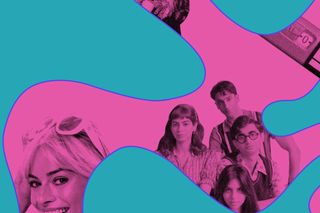
The Year in Pretty
The search for meaning, for ourselves, doesn’t end with beauty unless we turn feral – that’s if we don’t spend the next year ushering in feral girl summer.

“Only one standard of female beauty is sanctioned: the girl.”
We end the year with the nascent beginnings of what looks to be 2024’s main theme: color theory. What kind of skin do you wear: cool-toned or warm? You can tell by carefully examining your veins in the sunlight. If the blood they carry appears blue-purple, you’re cool; blue-green is warm. TikTok wants to find out what color of fabric it deserves to wear. Color theory prescribes a palette most suited to specific skin tones. Then, you have to figure out your season, essence, and if you’re lucky enough to figure out your personality, you find a palette that goes with it all. It applies to clothes but also: hair, makeup, shoes, just about everything. A growing number of posts across social media platforms compare and contrast celebrity faces wearing colors according to their palette and those which aren’t in their palette; the latter look is described as “washed out.” There is barely any discernible difference – which of course leaves one feeling uncultured.
There has arguably never been an era more hyperfixated on aesthetic, on sensory detail, as this one. 2023 is the year art went on strike as beauty itself took its place.
Earlier this year, whispers of a new antioxidant promising a different color abounded: glutathione, a substance made of amino acids glycine, cysteine, and glutamic acid which supposedly lightens skin. We have come a long way from Shahnaz Hussain’s ayurvedic fairness remedies. Gone are the days of the Fair & Lovely discourse, where advertisements posited loyal applicators of the cream as successful young women. Welcome to glutathione nation, where everyone’s taking it and nobody’s ashamed. Glow & Lovely, as it was renamed after the 2020 Black Lives Matter protests, is a relic of a bygone era, where cheap plastic packaging held creams and lotions and an impossible promise: Glutathione on the other hand is sleek and canny such as nothing else in a fairness-obsessed nation has been. Celebrities are taking it, spas and wellness centers offer it at a premium package, and nobody is talking about it. Glutathione is not advertised – if you know, you know. Unlike Fair & Lovely, which we’re allowed to criticize for its blatant colorism, glutathione is repackaged as an aesthetic treatment – a euphemism which allows it to feel better against the clamor about colorism for other similar products.
It corresponds with a rise in cosmetic procedures in India this year, which emerged as the 6th most-preferred destination for cosmetic tourism in the world. The market for chemical peels – another non-invasive “aesthetic” procedure – is also rising, and higher disposable incomes and awareness are apparently some reasons why. Meanwhile, the global economy is in a downturn and unemployment has reached an all-time high, but the aesthetic wellness industry marches on steadfastly. An army of consumer-citizens is now empowered to answer what will be next year’s question: what colors can – and should – you adorn yourself with?
Almost as practice, consumer-citizens faced another important question this year: what shade of pink goes with what type of skin? This was, as The Cut put it, “the year of the girl.” To say that pink, and Barbiecore, were back would be understating the paradigm shift that 2023 was for those two phenomena. Pink and Barbiecore became institutions, and Greta Gerwig’s Barbie fuelled what already appeared to be inevitable: the return of the girlies. Girlies are adult girls. Girlies are tired, intelligent, neglected, taken for granted, and underestimated. Girlies are unfinished girls. Girlies await their adulthood in their girliefication.
In a culture that taught us to grow up too fast, we swallowed our playfulness and reckless abandon. Barbie promised to return it to us, thereby ushering in an exceedingly pink year, replete with bows, baby girl frocks, frills and thrills dialed up to the nth degree. As a result, our perception of art itself shifted: art is what makes you feel good. Barbie made us feel good. Hence, it was art: the feminist film of the decade. Oppenheimer, riding on the coattails of Barbie, also turned into an aesthetic enterprise: men and boys dressed in black, wearing bowler hats, a cartoonish contrast to their Barbie-going counterparts. It was all fun and games. Barbenheimer was a phenomenon awash with color; the films themselves were besides the point. For all intents and purposes, the actual plot of both the films took place on Instagram and X. There may not be another moment like this in a while, but this one changed how we think: it brought us to an era where aesthetic supersedes depth. Aesthetic is enough.
The Met Gala, meanwhile, was pointedly lacking in color this year. In tribute to Karl Lagerfield, celebrities showed up in white and black. Everyone was upset about Karl Lagerfield: he was a racist man. But it no longer matters. In 2023, beauty alone is morality – and there was plenty of beauty to be found here. At the Met, just as with Barbenheimer, any mention of politics was promptly shooed off. The man lots of people hate was still honored. Politics didn’t seem to be the point, because everyone knows. The naysayers didn’t get the memo: Beauty is everything.
That said, sometimes beauty just wasn’t exciting enough. You could find more of a reaction to beauty than to politics (and when did the two get divorced?) – take this year’s Bollywood weddings. The pastel shades, the peachy, glowy, sunniness of it all: everyone was bored. They simply weren’t giving. The people wanted more. The ubiquitous sameness of the pastel aesthetic was simply too dull, too somnolent. Bring color back, everyone said. Bring back the bridal red, the marigold yellow, the brightness and pomp and splendor befitting of Indian rituals. Amid the cultural fixation with aesthetic, everything was compulsorily optimized for performance – including people’s personal choices on a personal day. Once again, color and aesthetic stood in for something deeper: in this case, the lack of excitement, the loss of vitality, the sedimentation of staidness.
What we crave, ultimately, is a return to porcelain perfection, uncomplicated politics, unfettered consciences, a great unmaking. Feminists in the generations preceding us have warned against all of this, and yet compulsory consumerism foisted on us has turned us defensive about our choices to undo their legacy. Capital has won in more ways than one: not just by turning us into compulsive consumers but knowing conspirators in our own consumption by a hungry, gnawing monoculture. The return of such a monoculture paradoxically signals its opposite: the loss of authenticity within subcultures.
The Archies, Zoya Akhtar’s launchpad for a clutch of new kids on the block, arguably tried to grapple with the question of what a return to innocence would look like. We simply know too much, we’re too aware of ourselves, so how do we escape? And yet it suffered the same problem: the retrofitting of Instagram aesthetics into a lost world, to stand-in for uncomplicated innocence. Aesthetics are indeed uncomplicated – but innocence isn’t. Neither is nostalgia. Both, from the vantage point of adulthood, are characterized by longing, a veneer of pleasure coating the surface of what is ultimately pain and loss. But in equating beauty with innocence, The Archies was a pretty, pastel, retro-glam package which, it seemed to say, was enough. But it wasn’t, judging from the unanimously tepid reviews that followed the lack of anything apart from aesthetic in the film.
It’s clear, then, that beauty isn’t all that we want. But in 2023, amid multiple catastrophes punctuating everyday life, beauty is what we got. If it looks good, it is good.
In the process of turning the gaze onto ourselves for the sake of performance, we’re arguably losing our sense of interiority and connectedness and all the messiness inherent within both. What does it mean to give this up and look outside of ourselves again? Some argue it is subversive, even unappealing – but that doesn’t have to be undesirable.
“The beauty of the feral is that it is not about oneself,” notes one obscure text riffing on sociologist Donna Haraway’s concept of the feral. The “feral” speaks to interconnectivity, chaos, disharmony. The search for meaning, for ourselves, doesn’t end with beauty unless we turn feral – that’s if we don’t spend the next year ushering in feral girl summer.
Rohitha Naraharisetty is a Senior Associate Editor at The Swaddle. She writes about the intersection of gender, caste, social movements, and pop culture. She can be found on Instagram at @rohitha_97 or on Twitter at @romimacaronii.
Related


How the Digitization of Money Is Changing Us
